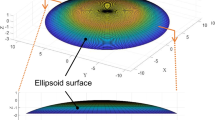Abstract
Energy and time savings are highly important aspects of green manufacturing. Ultrasonic vibration-assisted grinding (UVAG) is a high-efficiency, low-energy-consumption processing method for optical components made from hard and brittle materials. This work presents an experimental investigation of the specific grinding energy and the subsurface damage depth in UVAG of optical glasses to estimate the increased energy and time savings produced when using UVAG in optical glass manufacturing. The normal and tangential grinding forces of traditional grinding (TG) and axial UVAG processes on optical glasses were investigated for various machining parameters. The specific grinding energies during the TG and UVAG of the optical glasses were calculated and analyzed from the perspective of the energy consumption of the grinding process. The subsurface damage depths in optical glass during TG and UVAG were measured as an estimate of the machining quality, and the magnetorheological polishing spot method was used to analyze the time saved in subsequent polishing processes. The results show that UVAG can reduce energy consumption during the grinding of glass and produce significant time savings in subsequent polishing processes. The UVAG process therefore shows good potential for use in green manufacturing of optical components.








Similar content being viewed by others
References
Brinksmeier, E., Mutlugunes, Y., Klocke, F., Aurich, J. C., Shore, P., & Ohmori, H. (2010). Ultra-precision grinding. CIRP Annals Manufacturing Technology, 59(2), 652–671.
Cao, Z. C., Chi, F. C., & Zhao, X. (2016). A theoretical and experimental investigation of material removal characteristics and surface generation in bonnet polishing. Wear, 360, 137–146.
Chen, J. B., Fang, Q. H., Wang, C. C., Du, J. K., & Liu, F. (2016). Theoretical study on brittle–ductile transition behavior in elliptical ultrasonic assisted grinding of hard brittle materials. Precision Engineering, 46, 104–117.
Guo, H., Wu, Y., Lu, D., Fujimoto, M., & Nomura, M. (2014). Effects of pressure and shear stress on material removal rate in ultra-fine polishing of optical glass with magnetic compound fluid slurry. Journal of Materials Processing Technology, 214, 2759–2769.
Jiang, C., Cheng, J., & Wu, T. (2017). Theoretical model of brittle material removal fraction related to surface roughness and subsurface damage depth of optical glass during precision grinding. Precision Engineering, 49, 421–427.
Kim, W. B., Nam, E., Min, B. K., Choi, D. S., Jeon, T. J., & Jeon, E. C. (2015). Material removal of glass by magnetorheological fluid jet. International Journal of Precision Engineering and Manufacturing, 16(4), 629–637.
Komanduri, R. (1996). On material removal mechanisms in finishing of advanced ceramics and glasses. CIRP Annals Manufacturing Technology, 45(1), 509–5514.
Li, S. S., Wu, Y. B., Fujimoto, M., & Nomura, M. (2016). Improving the working surface condition of electroplated cubic boron nitride grinding quill in surface grinding of Inconel 718 by the assistance of ultrasonic vibration. Journal of Manufacturing Science and Engineering, 138(7), 1008.
Shorey, A. B., Jacobs, S. D., Kordonski, W. I., Roger, F., & Gans, R. F. (2001). Experiments and observations regarding the mechanisms of glass removal in magnetorheological finishing. Applied Optics, 40(1), 20–33.
Spur, G., & Holl, S. E. (1996). Ultrasonic assisted grinding of ceramics. Journal of Materials Processing Technology, 62, 287–293.
Tawakoli, T., & Azarhoushang, B. (2008). Influence of ultrasonic vibrations on dry grinding of soft steel. International Journal of Machine Tools and Manufacture, 48(14), 1585–1591.
Uhlmann, E. (1998). Surface formation in creep feed grinding of advanced ceramics with and without ultrasonic assistance. CIRP Annals Manufacturing Technology, 47(1), 249–252.
Venkatesh, V. C., Inasaki, I., Toenshof, H. K., Nakagawa, T., & Marinescu, I. D. (1995). Observations on polishing and ultraprecision machining of Semiconductor substrate materials. CIRP Annals Manufacturing Technology, 44(2), 611–618.
Yan, Y., Zhao, B., Wu, Y., Liu, C., & Zhu, X. (2006). Study on material removal mechanism of fine-crystalline ZrO2 ceramics under two dimensional ultrasonic grinding. Materials Science Forum, 532(533), 532–535.
Zhang, Z., Liu, W., & Song, Z. (2010). Particle size and surfactant effects on chemical mechanical polishing of glass using silica-based slurry. Applied Optics, 49(28), 5480–5485.
Zhao, Q. L., Chen, J. Y., Huang, H. T., & Fang, X. Y. (2011). Grinding damage of BK7 using copper-resin bond coarse-grained diamond wheel. International Journal of Precision Engineering and Manufacturing, 12(1), 5–13.
Zhou, M., & Zhao, P. (2016). Prediction of critical cutting depth for ductile-brittle transition in ultrasonic vibration assisted grinding of optical glasses. International Journal of Advanced Manufacturing Technology, 86(5), 1–10.
Acknowledgements
This work was supported by National Natural Science Foundation of China (51475310).
Author information
Authors and Affiliations
Corresponding author
Additional information
Publisher's Note
Springer Nature remains neutral with regard to jurisdictional claims in published maps and institutional affiliations
Rights and permissions
About this article
Cite this article
Jiang, C., Wu, T., Ye, H. et al. Estimation of Energy and Time Savings in Optical Glass Manufacturing When Using Ultrasonic Vibration-Assisted Grinding. Int. J. of Precis. Eng. and Manuf.-Green Tech. 6, 1–9 (2019). https://doi.org/10.1007/s40684-019-00022-7
Received:
Revised:
Accepted:
Published:
Issue Date:
DOI: https://doi.org/10.1007/s40684-019-00022-7




